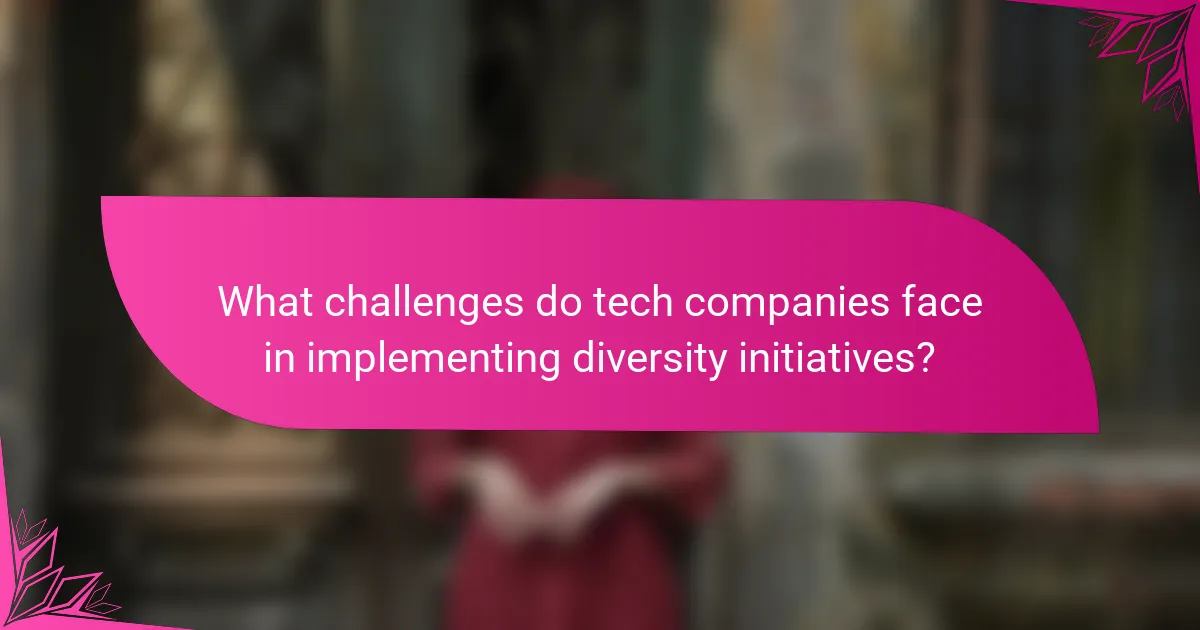Diversity initiatives in tech companies are essential for cultivating inclusive environments that enhance representation across various demographics. By implementing targeted hiring practices, employee resource groups, and comprehensive training programs, these organizations not only promote equity and belonging but also drive innovation and improve overall performance.

What are successful diversity initiatives in tech companies?
Successful diversity initiatives in tech companies focus on creating inclusive environments that promote representation across various demographics. These initiatives often include targeted hiring practices, employee resource groups, and ongoing training programs aimed at fostering a culture of equity and belonging.
Salesforce’s Equality Programs
Salesforce has implemented comprehensive equality programs that prioritize diverse hiring and equitable pay. The company conducts regular pay audits to ensure fair compensation across all demographics, addressing any disparities proactively.
Additionally, Salesforce supports various employee resource groups that provide networking and mentorship opportunities for underrepresented employees. These groups help create a sense of community and belonging within the organization.
Google’s Diversity Hiring Practices
Google’s approach to diversity hiring includes structured interview processes and diverse hiring panels to minimize bias. The company emphasizes the importance of attracting talent from a wide range of backgrounds by partnering with organizations that focus on underrepresented groups in tech.
Google also tracks diversity metrics and sets specific goals for improvement, ensuring accountability in its hiring practices. This data-driven approach allows the company to adapt its strategies based on what works best in promoting diversity.
Microsoft’s Inclusive Culture
Microsoft fosters an inclusive culture through initiatives that promote accessibility and support for employees with disabilities. The company has established guidelines for inclusive design, ensuring that products are usable by everyone, regardless of their abilities.
Moreover, Microsoft invests in training programs that educate employees about unconscious bias and cultural competency. This training helps build awareness and encourages a more inclusive workplace where all voices are valued.

How do diversity initiatives impact company performance?
Diversity initiatives significantly enhance company performance by fostering a more inclusive environment that drives innovation and employee satisfaction. Companies that prioritize diversity often see improved problem-solving capabilities and better financial outcomes.
Increased Innovation
Diversity initiatives promote a variety of perspectives, which can lead to increased innovation within tech companies. Teams composed of individuals from different backgrounds are more likely to generate unique ideas and solutions, enhancing creativity.
For example, companies like Google and Microsoft have reported that diverse teams contribute to higher rates of innovation. This is often reflected in the development of products that cater to a broader audience, ultimately leading to increased market share.
Improved Employee Satisfaction
Implementing diversity initiatives can lead to improved employee satisfaction by creating a more inclusive workplace culture. When employees feel valued and respected, they are more likely to be engaged and productive.
Research indicates that organizations with strong diversity programs often experience lower turnover rates and higher employee morale. For instance, companies that actively promote diversity and inclusion can see employee satisfaction scores rise significantly, which can translate into better overall performance.

What are the key components of effective diversity initiatives?
Effective diversity initiatives typically include leadership commitment, employee training programs, and data-driven metrics. These components work together to create an inclusive workplace that values diverse perspectives and fosters innovation.
Leadership Commitment
Leadership commitment is crucial for the success of diversity initiatives. When executives actively support and participate in diversity efforts, it sets a tone for the entire organization, encouraging employees at all levels to prioritize inclusion.
Leaders should communicate the importance of diversity regularly and integrate it into the company’s mission and values. This can be achieved through public statements, participation in diversity events, and accountability measures tied to leadership performance.
Employee Training Programs
Employee training programs are essential for raising awareness and understanding of diversity issues. These programs can include workshops, seminars, and online courses that cover topics such as unconscious bias, cultural competency, and inclusive practices.
To be effective, training should be ongoing rather than a one-time event. Companies might consider implementing regular refreshers and specialized training for different roles, ensuring that all employees have the tools they need to contribute to a diverse workplace.
Data-Driven Metrics
Data-driven metrics help organizations measure the effectiveness of their diversity initiatives. By collecting and analyzing data on employee demographics, hiring practices, and retention rates, companies can identify areas for improvement and track progress over time.
It is beneficial to set specific, measurable goals related to diversity and regularly review these metrics. For example, a company might aim to increase the representation of underrepresented groups by a certain percentage within a defined timeframe, allowing for targeted strategies to achieve those goals.

What challenges do tech companies face in implementing diversity initiatives?
Tech companies encounter several challenges when implementing diversity initiatives, including resistance to change and a lack of resources. These obstacles can hinder progress and limit the effectiveness of diversity programs.
Resistance to Change
Resistance to change is a significant barrier for tech companies aiming to enhance diversity. Employees may feel threatened by new policies or perceive them as unnecessary, leading to pushback against initiatives. This resistance can stem from a lack of understanding or fear of the unknown.
To address this challenge, companies should foster open communication about the benefits of diversity. Engaging employees in discussions and providing training can help alleviate fears and build support for initiatives. Highlighting success stories from other organizations can also serve as motivation.
Lack of Resources
A lack of resources, both financial and human, often hampers diversity initiatives in tech companies. Many organizations struggle to allocate sufficient budgets for training, outreach, and recruitment efforts aimed at increasing diversity. Additionally, limited staff dedicated to diversity efforts can slow down implementation.
To overcome this challenge, companies can prioritize diversity in their strategic planning. Seeking partnerships with organizations that specialize in diversity can provide valuable resources and expertise. Companies might also consider reallocating existing budgets or applying for grants to support their diversity initiatives.

How can tech companies measure the success of diversity initiatives?
Tech companies can measure the success of diversity initiatives through various methods, focusing on both qualitative and quantitative data. Effective measurement involves gathering feedback from employees and analyzing relevant diversity metrics to assess progress and identify areas for improvement.
Employee Surveys
Employee surveys are a direct way to gauge perceptions of diversity initiatives within a company. These surveys can include questions about inclusivity, representation, and overall workplace culture. Regularly conducting these surveys, at least annually, allows companies to track changes over time and adjust strategies accordingly.
When designing surveys, consider using a mix of quantitative ratings and open-ended questions to capture diverse perspectives. Ensure anonymity to encourage honest feedback, and follow up with action plans based on the results to demonstrate commitment to improvement.
Diversity Metrics Analysis
Diversity metrics analysis involves examining data related to employee demographics, hiring practices, and retention rates. Key metrics may include the percentage of underrepresented groups in various roles, promotion rates, and employee turnover statistics. Analyzing these metrics helps identify disparities and informs targeted initiatives to enhance diversity.
Companies should benchmark their metrics against industry standards to evaluate their performance effectively. For example, if a tech firm finds that only a small percentage of its leadership roles are held by women or minorities, it may need to implement specific recruitment and mentorship programs to address this gap.

What are some emerging trends in diversity initiatives in tech?
Emerging trends in diversity initiatives in tech focus on creating inclusive environments that prioritize mental health and leverage technology for equitable recruitment. Companies are increasingly recognizing the importance of holistic approaches that address both employee well-being and fair hiring practices.
Focus on Mental Health
Tech companies are placing greater emphasis on mental health as a critical component of diversity initiatives. This includes providing resources such as counseling services, mental health days, and wellness programs to support employees’ emotional well-being.
For instance, organizations may implement regular mental health check-ins and workshops to foster a supportive culture. Offering flexible work arrangements can also help employees manage stress and maintain a healthy work-life balance.
Integration of AI in Recruitment
The integration of artificial intelligence in recruitment processes is transforming how tech companies approach diversity. AI tools can help eliminate bias in job descriptions and candidate evaluations, promoting a more equitable hiring process.
Companies should consider using AI-driven platforms that analyze resumes and applications without gender or ethnic biases. However, it’s crucial to regularly audit these systems to ensure they align with diversity goals and do not inadvertently reinforce existing biases.


